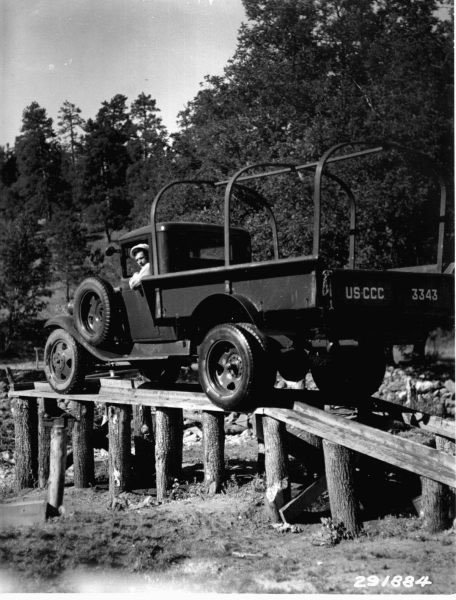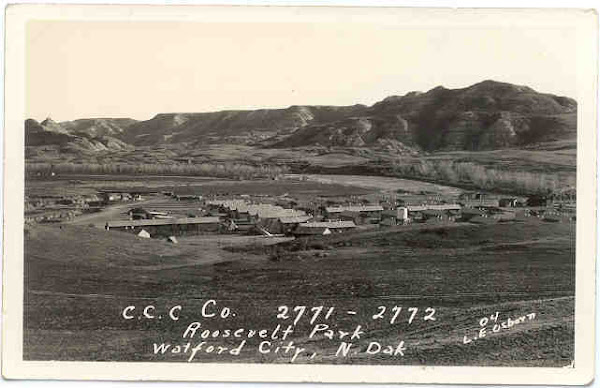Massachusetts was situated in the 1st Corps area,
which also included Maine, New Hampshire, Vermont, Rhode Island and
Connecticut. Some 50 or so parks and
forests in Massachusetts benefited from the work of the CCC and information on
most of those locations can be accessed on a website maintained by the State of
Massachusetts that you can access here. While there is not a great deal of detail
regarding specific projects, camp numbers or company numbers on this site, it
is admirable that the state government has taken the time and effort to list
where the CCC worked and to provide some information regarding what CCC-built
improvements you might encounter at a given location.
An online copy of the book The Civilian Conservation Corps, Shaping the Forests and Parks of
Massachusetts: A Statewide Survey of Civilian Conservation Corps Resources
(Jan. 1999) can be accessed here. The page is formatted to allow users to
search the text for specific words. For
example a search for the word “accident” will pull up the page that discusses a
monument dedicated to five enrollees killed in a truck accident at Sandisfield
State Park in December 1934, which we will revisit later in this article. This truly is a worthwhile resource for
anyone seeking information regarding the work of the CCC in Massachusetts.
Much has been made of the “wish list” of projects that the
state’s and technical services (Forest Service, National Park Service and the
Bureau of Reclamation, for example) had when the CCC was created in 1933. So many work projects and maintenance tasks
had gone undone for a number of years leading up to the Great Depression that
when Franklin Roosevelt created the CCC, agencies like the Forest Service had long
lists of projects that were, indeed “shovel ready” and in need of workers to
carry out the effort. Such was not
necessarily the case in Massachusetts, according to Perry H. Merrill, writing
in Roosevelt’s Forest Army: A History of
the Civilian Conservation Corps.
State leaders realized they would need to purchase acreage for parks and
forests if they hoped to keep Massachusetts enrollees working in their home
state. According to Merrill, some 50,585
acres of state lands were purchased for this reason between 1933 and 1939.
We have some enrollment and work statistics from 1937 and
1939 that shed light on the impact of the CCC in Massachusetts, which were
reported in the Annual Reports. For example, total monthly enrollment in
Massachusetts between July 1936 and June 1937 was as follows:
July 1936: 12,266
August 1936: 11,408
September 1936: 8,003
October 1936: 11,630
November 1936: 10,929
December 1936: 10,348
January 1937: 12,114
February 1937: 11,372
March 1937: 7,817
April 1937: 10,269
May 1937: 9,391
June 1937: 8,341
The distribution of CCC camps in Massachusetts in
fiscal year 1937 was as follows:
State Park Camps: 16
State Forest Camps: 17
Private Forest Camps: 4
Military Reservation Camps: 1
 |
| US Forest Service photo, published in Stan Cohen's The Tree Army |
The annual reports include fold out charts that list
project totals for dozens of types of work broken down by state. Examples of specific work accomplished in
Massachusetts in fiscal year 1937:
Camp Stoves and Fireplaces: 142
Vehicle Bridges: 14
Topographic Surveys: 704.6
acres
Signs, Markers, Monuments: 1,735
Emergency Work, Search & Rescue: 733 man days
Emergency Work, “Other”: 21,101 man days
The Annual
Report for fiscal year 1939 reported total monthly enrollment in Massachusetts
between July 1938 and June 1939 as follows:
July 1938: 9,590
August 1938: 9,114
September 1938: 7,888
October 1938: 9,355
November 1938: 8,930
December 1938: 7,124
January 1939: 9,493
February 1939: 9,229
March 1939: 7,032
April 1939: 9,206
May 1939: 8,809
June 1939: 6,272
The 1939 Annual
Report includes more detail than the 1937 report. For example, the 1939 report gives totals for
selection of enrollees by state. So, in
fiscal year 1939 we know that 9,369 junior enrollees and 590 veterans were
enrolled from the state of Massachusetts.
The distribution of CCC camps in Massachusetts in
fiscal year 1939 was as follows:
State Park Camps: 9
State Forest Camps: 10
Private Forest Camps: 1
Examples of specific work accomplished in Massachusetts
in fiscal year 1939:
Camp Stoves and Fireplaces: 111
Vehicle Bridges: 4
Surveys: 2,711 man days
Signs, Markers, Monuments: 141
Emergency Work: 103,949
man days
It is always interesting to speculate regarding
why enrollment and work totals varied from year to year in the CCC. We know that as the economy improved,
enrollment in the CCC began to drop off because young men could more easily
find work. It also seems that CCC
enrollment was somewhat seasonal in some regions, with enrollment numbers
dropping off in agricultural areas during harvest season. Such may not have been the case with
Massachusetts but it is possible to speculate with some certainty regarding one
form of CCC work project: the category termed “emergency work.” We know that New England was hit by a
devastating hurricane on September 21, 1938 and, according to Aram Goudsouzian
in The Hurricane of 1938, 680 people
perished, 72 million feet of power lines were knocked down putting 88 percent
of the region in darkness and countless trees were uprooted. In the aftermath of the disaster Goudsouzian
reports, “Ten thousand workers from the Civilian Conservation Corps, which employed
young men in forestry and flood control programs, cleared streets and helped
save flood-threatened areas in Connecticut and Massachusetts.” In hindsight, it’s little surprise then that
the CCC focus on “emergency work” in Massachusetts jumped from around 21,000
man days in fiscal year 1937 to nearly 104,000 man days in fiscal year 1939,
the year the big hurricane struck.
(Remember that fiscal year
1939 included the period when the hurricane struck in 1938.)
Happy Days
was the official national newspaper of the Civilian Conservation Corps and it
included reports of camp activities in all of the 9 Corps areas. Sadly, some of the content of Happy Days was not so upbeat; accidents
and fatalities were commonly reported and no fewer than eleven Massachusetts
fatalities were reported in the pages of Happy
Days between 1933 and 1940.
According to the January 2, 1934 issue of Happy
Days, an enrollee in Company 1102 died from appendicitis. The aforementioned book The Civilian Conservation Corps, Shaping the Forests and Parks of
Massachusetts: A Statewide survey of Civilian Conservation Corps Resources notes
that Company 1102 was assigned to Camp
S-63, which was established at Otter River State Forest in 1934. Sadly, the microfilm copy of Happy Days is not clear enough to read
the enrollee’s name in this case but it appears to have been George –aki.
The most tragic episode in Massachusetts’ CCC
history was likely the death of five enrollees who were killed in a truck
accident on December 16, 1934 while en route to 8:00 AM mass at St. Peter’s
Church. The tragedy was reported on page
1 of the December 22, 1934 issue of Happy
Days. Killed in the truck accident
were enrollees Benoit Helie, James Leavy, Francis Kippenberger, Elden Holland
and Frank Capozzuto. Presumably, the
dead enrollees had been assigned to Camp S-71, in Company 196, based on
information in the aforementioned online resource, The Civilian Conservation Corps, Shaping the Forests and Parks of
Massachusetts. You can also read an
online article from 1997 about the area and the monument here.
Two years after the truck accident, Happy Days had the decidedly unhappy duty of reporting the death of Santino Boccabello of Company 1173, Salem, Massachusetts. According to the December 12, 1936 issue of Happy Days, enrollee Boccabello was killed in a landslide while working in a gravel pit. Ironically, the same issue of Happy Days contained an article reporting that the monthly fatal accidents were down by 31% in the CCC. No doubt the news came as cold comfort for Boccabello’s buddies in camp.
Four Massachusetts CCC fatalities are separated by
space and time but remain related by virtue of their commonality: in each case
the enrollee was struck by a car. The
death of enrollee Henry Piezarek, Company 135, Palmer, Massachusetts, was
reported in the July 2, 1938 issue of Happy
Days. Russell Crozier, assigned to
Company 1181, North Reading, Massachusetts was struck by a truck while on a
pass from camp, the report of his death appearing in the August 5, 1939 issue
of Happy Days. The front page of the
January 20, 1940 issue of Happy Days carried the sad news that enrollee Reed
Berry, from Company 4426, Lexington, Massachusetts, was struck and killed by a
car while on leave. Finally, Joseph
Budrunias, a veteran with Company 1181, was struck and killed by a car while on
leave; his death was reported on page 1 of the March 16, 1940 issue of Happy Days.
 To be sure the primary purpose of Happy Days was to convey positive upbeat
stories about life and work in the CCC.
Any given issue might contain stories both earth shattering and obscure
from camps across the nation. The May
30, 1936 issue of Happy Days included
a number of brief articles detailing activities in Massachusetts camps,
including an account of an enrollee field trip to a local dam, a report that
Company 1139 at West Townsend, Massachusetts was preparing to reactivate their
camp radio station and news that Company 1189 was working on a poultry project.
To be sure the primary purpose of Happy Days was to convey positive upbeat
stories about life and work in the CCC.
Any given issue might contain stories both earth shattering and obscure
from camps across the nation. The May
30, 1936 issue of Happy Days included
a number of brief articles detailing activities in Massachusetts camps,
including an account of an enrollee field trip to a local dam, a report that
Company 1139 at West Townsend, Massachusetts was preparing to reactivate their
camp radio station and news that Company 1189 was working on a poultry project.
Elsewhere in the same issue is a brief story about
the work of a crew of enrollees in Company 1199 stationed at East Douglas,
Massachusetts. According to the report,
the crew accounted for the planting of 125,000 trees in the span of just 700
man-days. Put in perspective, one 6-man
detail from this crew planted 3,600 trees in a single day! The article goes on to detail some of the
recreational activities taking place in the camp after work ours.
In another article in the same column of print,
the May 30, 1936 issue of Happy Days reported that enrollees in Company 143 at
North Adams, Massachusetts had created a model club with 12 men working
individually on model airplanes as working as a group on a large plane model to
be displayed in the camp recreation hall.
Berg, Shary Page, The Civilian Conservation Corps, Shaping the Forests and Parks of
Massachusetts: A Statewide Survey of Civilian Conservation Corps Resources,
January, 1999, Landscape Preservation Planning and Design, Cambridge, MA. (Accessible online here.)
Happy Days,
May 30, 1936.
Merrill, Perry H, Roosevelt’s Forest Army, 1981,
Perry H. Merrill, Publisher.
U.S. Government Printing Office, Annual Report of the Director of Emergency
Conservation Work, Fiscal Year Ended June 30, 1937.
U.S. Government Printing Office, Annual Report of the Director of the
Civilian Conservation Corps Fiscal Year Ended June 30, 1939.
Copyright, 2014, Michael I. Smith





























